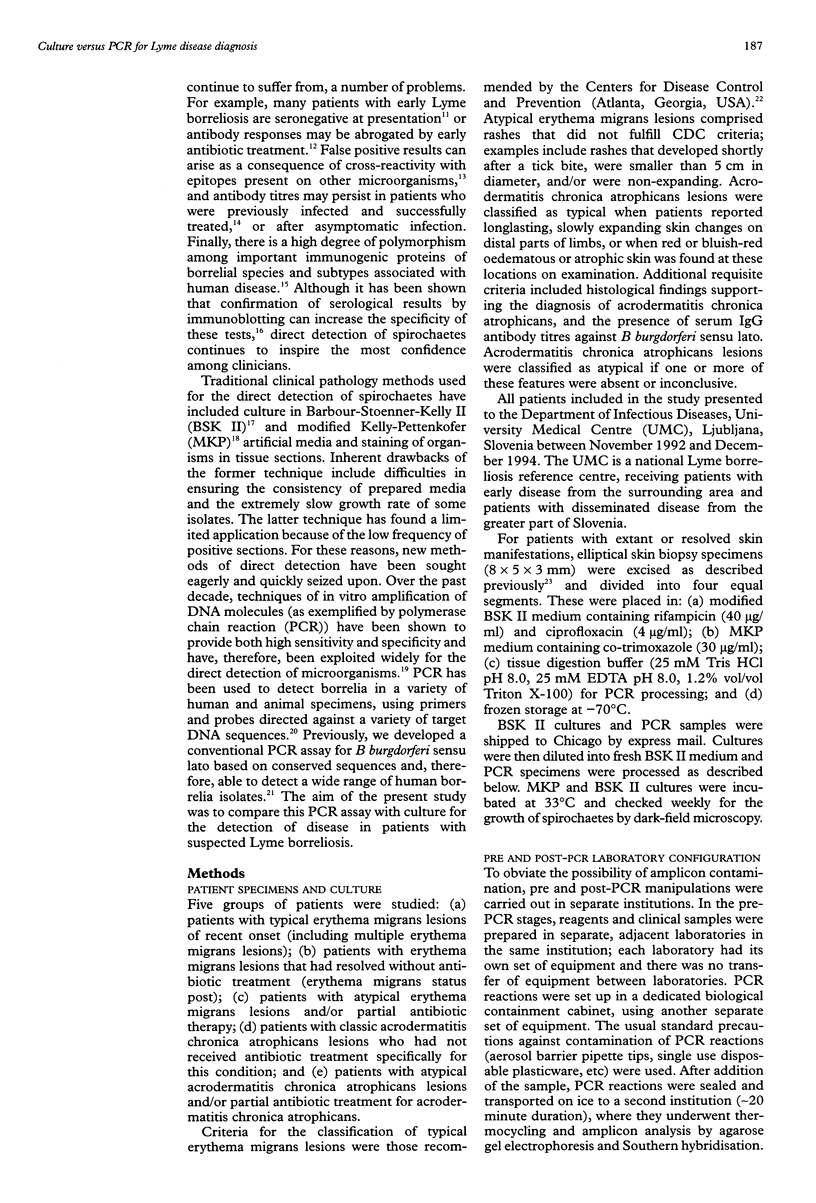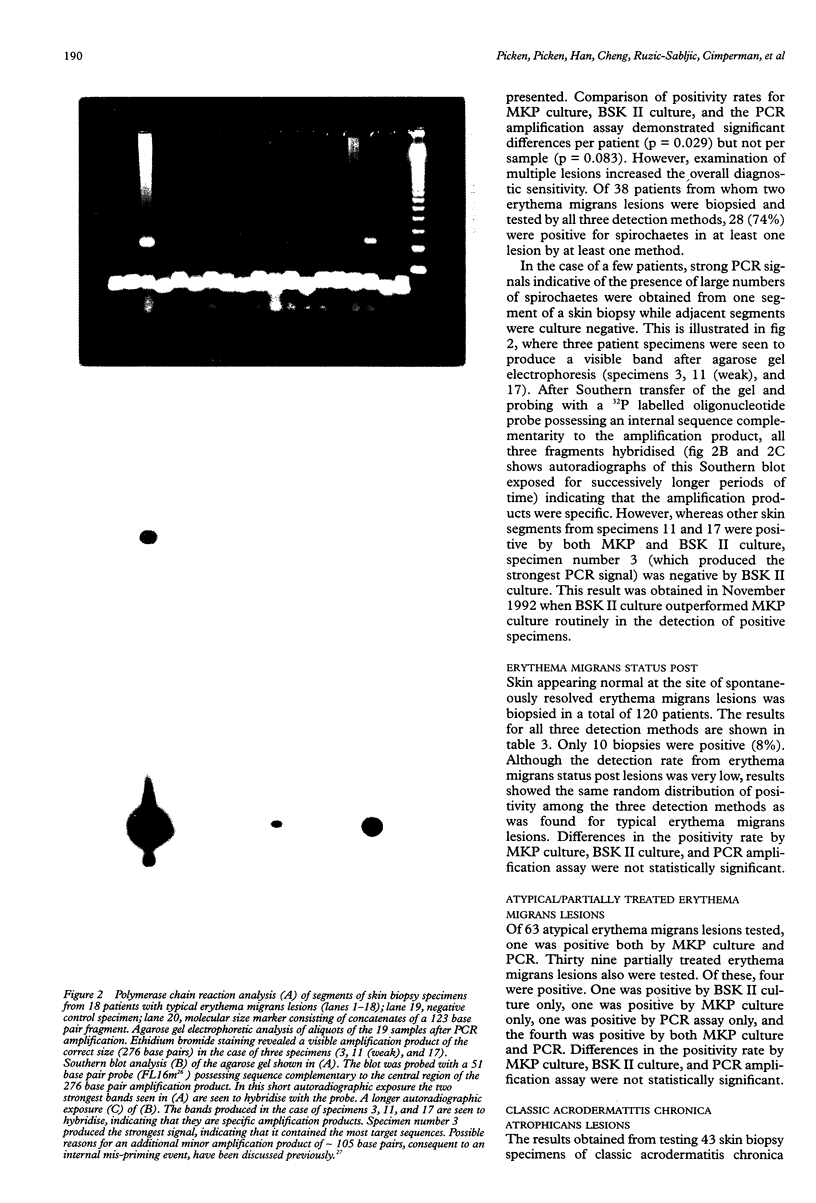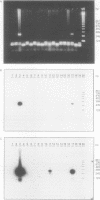Abstract
AIM: To compare polymerase chain reaction (PCR) amplification of borrelial DNA and culture isolation of spirochaetes for the diagnosis of Lyme borreliosis by direct detection of Borrelia burgdorferi sensu lato in patients with erythema migrans and acrodermatitis chronica atrophicans lesions. METHODS: Skin biopsy specimens from erythema migrans and acrodermatitis chronica atrophicans lesions were subdivided and tested by PCR amplification assay and culture using two artificial growth media, Barbour-Stoenner-Kelly II (BSK II) and modified Kelly-Pettenkofer (MKP). Five classes of lesions were studied: typical erythema migrans, spontaneously resolved erythema migrans, atypical/partially treated erythema migrans, typical acrodermatitis chronica atrophicans, and atypical/partially treated acrodermatitis chronica atrophicans. RESULTS: For both erythema migrans and acrodermatitis chronica atrophicans lesions, the most sensitive detection method was MKP culture. PCR was less sensitive than MKP culture, but more sensitive than BSK II culture. Results for 758 typical erythema migrans specimens showed positivity rates of 36% for MKP, 25% for PCR, and 24% for BSK II. Differences were statistically significant. The overall positivity rate for all three methods combined was 54%, but few specimens (6%) were positive by all three methods. Examination of multiple erythema migrans lesions from the same patient increased the diagnostic yield. These findings, and similar results for acrodermatitis chronica atrophicans lesions, suggest that the distribution of spirochaetes in skin biopsies is not homogeneous. CONCLUSIONS: Although possessing the potential to provide a rapid diagnosis, PCR is not more sensitive than culture for the direct detection of borrelia. Spirochaetes appear to be unevenly distributed throughout biopsy specimens, suggesting that diagnosis of Lyme borreliosis by direct detection of the causative agent in skin lesions in vulnerable to sample bias.
Full text
PDF







Images in this article
Selected References
These references are in PubMed. This may not be the complete list of references from this article.
- Asbrink E., Hovmark A. Early and late cutaneous manifestations in Ixodes-borne borreliosis (erythema migrans borreliosis, Lyme borreliosis). Ann N Y Acad Sci. 1988;539:4–15. doi: 10.1111/j.1749-6632.1988.tb31833.x. [DOI] [PubMed] [Google Scholar]
- Asbrink E., Hovmark A. Successful cultivation of spirochetes from skin lesions of patients with erythema chronicum migrans Afzelius and acrodermatitis chronica atrophicans. Acta Pathol Microbiol Immunol Scand B. 1985 Apr;93(2):161–163. doi: 10.1111/j.1699-0463.1985.tb02870.x. [DOI] [PubMed] [Google Scholar]
- Baranton G., Postic D., Saint Girons I., Boerlin P., Piffaretti J. C., Assous M., Grimont P. A. Delineation of Borrelia burgdorferi sensu stricto, Borrelia garinii sp. nov., and group VS461 associated with Lyme borreliosis. Int J Syst Bacteriol. 1992 Jul;42(3):378–383. doi: 10.1099/00207713-42-3-378. [DOI] [PubMed] [Google Scholar]
- Barbour A. G. Isolation and cultivation of Lyme disease spirochetes. Yale J Biol Med. 1984 Jul-Aug;57(4):521–525. [PMC free article] [PubMed] [Google Scholar]
- Berardi V. P., Weeks K. E., Steere A. C. Serodiagnosis of early Lyme disease: analysis of IgM and IgG antibody responses by using an antibody-capture enzyme immunoassay. J Infect Dis. 1988 Oct;158(4):754–760. doi: 10.1093/infdis/158.4.754. [DOI] [PubMed] [Google Scholar]
- Berger B. W., Clemmensen O. J., Ackerman A. B. Lyme disease is a spirochetosis. A review of the disease and evidence for its cause. Am J Dermatopathol. 1983 Apr;5(2):111–124. [PubMed] [Google Scholar]
- Berger B. W., Johnson R. C., Kodner C., Coleman L. Failure of Borrelia burgdorferi to survive in the skin of patients with antibiotic-treated Lyme disease. J Am Acad Dermatol. 1992 Jul;27(1):34–37. doi: 10.1016/0190-9622(92)70152-6. [DOI] [PubMed] [Google Scholar]
- Boom R., Sol C. J., Salimans M. M., Jansen C. L., Wertheim-van Dillen P. M., van der Noordaa J. Rapid and simple method for purification of nucleic acids. J Clin Microbiol. 1990 Mar;28(3):495–503. doi: 10.1128/jcm.28.3.495-503.1990. [DOI] [PMC free article] [PubMed] [Google Scholar]
- Burgdorfer W., Barbour A. G., Hayes S. F., Benach J. L., Grunwaldt E., Davis J. P. Lyme disease-a tick-borne spirochetosis? Science. 1982 Jun 18;216(4552):1317–1319. doi: 10.1126/science.7043737. [DOI] [PubMed] [Google Scholar]
- Canica M. M., Nato F., du Merle L., Mazie J. C., Baranton G., Postic D. Monoclonal antibodies for identification of Borrelia afzelii sp. nov. associated with late cutaneous manifestations of Lyme borreliosis. Scand J Infect Dis. 1993;25(4):441–448. doi: 10.3109/00365549309008525. [DOI] [PubMed] [Google Scholar]
- Ciesielski C. A., Markowitz L. E., Horsley R., Hightower A. W., Russell H., Broome C. V. The geographic distribution of Lyme disease in the United States. Ann N Y Acad Sci. 1988;539:283–288. doi: 10.1111/j.1749-6632.1988.tb31862.x. [DOI] [PubMed] [Google Scholar]
- Craft J. E., Grodzicki R. L., Steere A. C. Antibody response in Lyme disease: evaluation of diagnostic tests. J Infect Dis. 1984 May;149(5):789–795. doi: 10.1093/infdis/149.5.789. [DOI] [PubMed] [Google Scholar]
- Feder H. M., Jr, Gerber M. A., Luger S. W., Ryan R. W. Persistence of serum antibodies to Borrelia burgdorferi in patients treated for Lyme disease. Clin Infect Dis. 1992 Nov;15(5):788–793. doi: 10.1093/clind/15.5.788. [DOI] [PubMed] [Google Scholar]
- Kuiper H., van Dam A. P., Spanjaard L., de Jongh B. M., Widjojokusumo A., Ramselaar T. C., Cairo I., Vos K., Dankert J. Isolation of Borrelia burgdorferi from biopsy specimens taken from healthy-looking skin of patients with Lyme borreliosis. J Clin Microbiol. 1994 Mar;32(3):715–720. doi: 10.1128/jcm.32.3.715-720.1994. [DOI] [PMC free article] [PubMed] [Google Scholar]
- Magnarelli L. A., Fikrig E., Berland R., Anderson J. F., Flavell R. A. Comparison of whole-cell antibodies and an antigenic flagellar epitope of Borrelia burgdorferi in serologic tests for diagnosis of Lyme borreliosis. J Clin Microbiol. 1992 Dec;30(12):3158–3162. doi: 10.1128/jcm.30.12.3158-3162.1992. [DOI] [PMC free article] [PubMed] [Google Scholar]
- Moter S. E., Hofmann H., Wallich R., Simon M. M., Kramer M. D. Detection of Borrelia burgdorferi sensu lato in lesional skin of patients with erythema migrans and acrodermatitis chronica atrophicans by ospA-specific PCR. J Clin Microbiol. 1994 Dec;32(12):2980–2988. doi: 10.1128/jcm.32.12.2980-2988.1994. [DOI] [PMC free article] [PubMed] [Google Scholar]
- Nadelman R. B., Nowakowski J., Forseter G., Bittker S., Cooper D., Goldberg N., McKenna D., Wormser G. P. Failure to isolate Borrelia burgdorferi after antimicrobial therapy in culture-documented Lyme borreliosis associated with erythema migrans: report of a prospective study. Am J Med. 1993 Jun;94(6):583–588. doi: 10.1016/0002-9343(93)90208-7. [DOI] [PubMed] [Google Scholar]
- Neubert U., Krampitz H. E., Engl H. Microbiological findings in erythema (chronicum) migrans and related disorders. Zentralbl Bakteriol Mikrobiol Hyg A. 1986 Dec;263(1-2):237–252. doi: 10.1016/s0176-6724(86)80127-4. [DOI] [PubMed] [Google Scholar]
- Picken M. M., Picken R. N., Han D., Cheng Y., Strle F. Single-tube nested polymerase chain reaction assay based on Flagellin gene sequences for detection of Borrelia burgdorferi sensu lato. Eur J Clin Microbiol Infect Dis. 1996 Jun;15(6):489–498. doi: 10.1007/BF01691317. [DOI] [PubMed] [Google Scholar]
- Postic D., Edlinger C., Richaud C., Grimont F., Dufresne Y., Perolat P., Baranton G., Grimont P. A. Two genomic species in Borrelia burgdorferi. Res Microbiol. 1990 May;141(4):465–475. doi: 10.1016/0923-2508(90)90072-x. [DOI] [PubMed] [Google Scholar]
- Preac-Mursic V., Wilske B., Schierz G. European Borrelia burgdorferi isolated from humans and ticks culture conditions and antibiotic susceptibility. Zentralbl Bakteriol Mikrobiol Hyg A. 1986 Dec;263(1-2):112–118. doi: 10.1016/s0176-6724(86)80110-9. [DOI] [PubMed] [Google Scholar]
- Steere A. C. Lyme disease. N Engl J Med. 1989 Aug 31;321(9):586–596. doi: 10.1056/NEJM198908313210906. [DOI] [PubMed] [Google Scholar]
- Strle F., Cheng Y., Cimperman J., Maraspin V., Lotric-Furlan S., Nelson J. A., Picken M. M., Ruzic-Sabljic E., Picken R. N. Persistence of Borrelia burgdorferi sensu lato in resolved erythema migrans lesions. Clin Infect Dis. 1995 Aug;21(2):380–389. doi: 10.1093/clinids/21.2.380. [DOI] [PubMed] [Google Scholar]
- Vogelstein B., Gillespie D. Preparative and analytical purification of DNA from agarose. Proc Natl Acad Sci U S A. 1979 Feb;76(2):615–619. doi: 10.1073/pnas.76.2.615. [DOI] [PMC free article] [PubMed] [Google Scholar]
- Wallich R., Helmes C., Schaible U. E., Lobet Y., Moter S. E., Kramer M. D., Simon M. M. Evaluation of genetic divergence among Borrelia burgdorferi isolates by use of OspA, fla, HSP60, and HSP70 gene probes. Infect Immun. 1992 Nov;60(11):4856–4866. doi: 10.1128/iai.60.11.4856-4866.1992. [DOI] [PMC free article] [PubMed] [Google Scholar]
- de Koning J., Hoogkamp-Korstanje J. A. Diagnosis of Lyme disease by demonstration of spirochetes in tissue biopsies. Zentralbl Bakteriol Mikrobiol Hyg A. 1986 Dec;263(1-2):179–188. doi: 10.1016/s0176-6724(86)80121-3. [DOI] [PubMed] [Google Scholar]




